Hell & High Water
THE WESTERN SKY is bleeding out like a giant open wound. Rich swaths of crimson and gold spill from a slit in the clouds, oozing across the waves of the Pacific like beautiful gore. It’s as if the horizon itself has committed hara-kiri. Even for the saltiest of mariners navigating these notorious waters near the mouth of the Columbia River, the sun’s late-afternoon curtain call is enough to inspire awed silence.
Inside the cockpit of the pilot boat Columbia—a mean, diesel-powered, neon-orange torpedo—skipper David Fastabend and his deckhand pay the view their respects with a nod and a stone-faced stare. A gray whale surfaces off the bow, its exhale of spray visible from a quarter-mile away. The only mammal that seems unfazed by the majestic panorama is one Kevin Dooney. In thirty minutes, he will leap from the bow of the 74-foot Columbia and grab onto a battered rope ladder dangling from the Fragrant Island, a 580-foot Japanese bulk carrier en route to the port of Kalama at twelve knots, roughly fourteen miles per hour. In rolling seas, Dooney must climb twenty-five feet to the deck of the Island, where he will take control of a ship that’s longer than a football field, then guide it into the teeth of the Columbia River bar.
The bar is a shifting sandbar in the seventeen-mile entryway to the Columbia River, the largest river in the Pacific Northwest and the fourth largest in the country. Without the calming buffer of a delta, the Columbia slams into sea swells; the colliding currents, along with weather conditions that can shift within minutes, make this one of the most unpredictable and dangerous stretches of navigable water on the planet. Today is Dooney’s one-year anniversary with the pilots, and already he’s heard enough horror stories to fill the forty-minute ride out to the Fragrant Island: waves standing nearly forty feet high, vessels dragging their anchors, lifeboats swept from decks, rudders of massive ships driven out of the water and rendered powerless.
Since 1792, at least two thousand ships have sunk here in the “graveyard of the Pacific”; Dooney is among only sixteen men and women licensed to take the big commercial vessels of the world through it. They belong to the Columbia River Bar Pilots, a limited liability company that dates back to 1846. At forty-four, Dooney is the youngest pilot. Before this, he guided oil tankers through the arctic waters off the Siberian coast, which offered plenty of another kind of peril: Ice. Storms. Ice storms. And yet there’s a reason he ended up working this deadly triangle of water just west of Astoria. “This place has a reputation,” he says. “Coming up, I knew the bar was the real deal.”
Right now, though, his energy doesn’t suggest nervousness, but rather the giddiness of someone trying to stifle a gut laugh. The smile on his freckled face is expectant, like he’s dosed my drink and is waiting for me to buckle. It dawns on me that he thinks I’m going to vomit. “All I’m saying,” he says, his pale blue eyes never leaving mine, “is that the trash can is right here.” He opens a metal cabinet drawer in the stern. “And if you can’t make that, the sink is right here.”
His assumption is not unfounded. Six miles off the coast, the horizon is a moving target. The Columbia slams itself into, up, over, and down the unrelenting chop. The state-of-the-art boat is barely a year old and is worth more than $4 million; it’s built to survive a 360-degree roll, and its twin engines power jets that blast four tons of water per second, a force that could fill an Olympic-size pool in fifteen seconds. None of which stops me from twisting and grinding against the brass pole behind the captain’s chair like a Friday-night stripper.
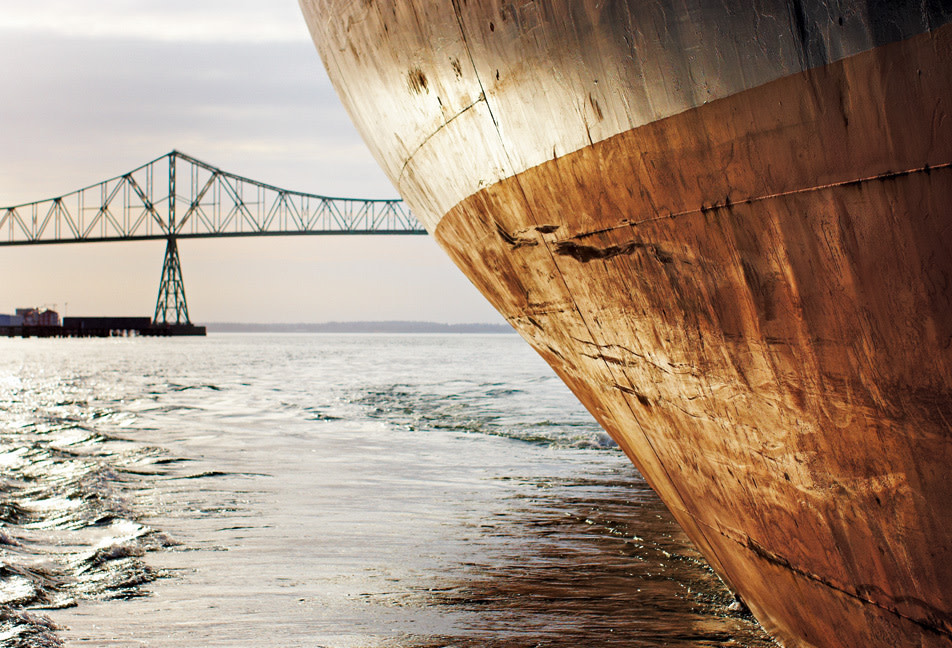
The South Korean Diamond Ray en route to Portland.
By bar standards, the conditions are tame. It’s March: the deadly winter season when the pilots earn their reputation (and their $180,000 payday, in a solid economy) is nearly over. Still, as the Fragrant Island reveals itself in the dying light, the mood inside the Columbia tenses.
Fastabend begins communicating with the captain, asking him to adjust his speed. “If something goes wrong,” he tells me gravely, “stay clear.” He throws on a float coat, which is equipped for flotation and visibility in these forty-degree waters, but not for warmth. Dooney puts one on, too. Minutes ago, he was telling tales and goading me into throwing up, but now he grows quiet, as if sending up a silent prayer. Then he tells Fastabend, “I’m leaving my book here, David. You mind bringing it back for me?”
The book is Joseph Campbell’s The Hero with a Thousand Faces, a study of the hero archetype throughout history. “A hero ventures forth from the world of common day into a region of supernatural wonder,” Campbell writes in the introduction. “Fabulous forces are there encountered and a decisive victory is won: the hero comes back from this mysterious adventure with the power to bestow boons on his fellow man.”
Dooney moves out the aft door, around the cockpit, and positions himself on the port bow. Fastabend matches the speed of the Fragrant Island and steers against its hull, gently and repeatedly ramming the black-and-red wall of steel, the tides moving us up and down as well as side to side. From the air, the Columbia must look like a tiny dog humping a skyscraper.
Synchronizing his stance to the sway of the ship, Dooney makes to step onto the Island’s ladder. A wave smacks him off balance. He resets himself, anchors his feet, tenses, and then launches himself toward the ladder.
One leg on a rung, the other still on the Columbia, he swings all his weight toward the hull of the enormous vessel. A tick on the side of a mastiff, he begins to climb, whitecaps swarming at his feet. If he fell now, he could easily be killed. But he does not fall. He climbs. Hand over hand, foot by foot. At the top, his legs disappear over the railing of the Fragrant Island.
The hero ventures forth.
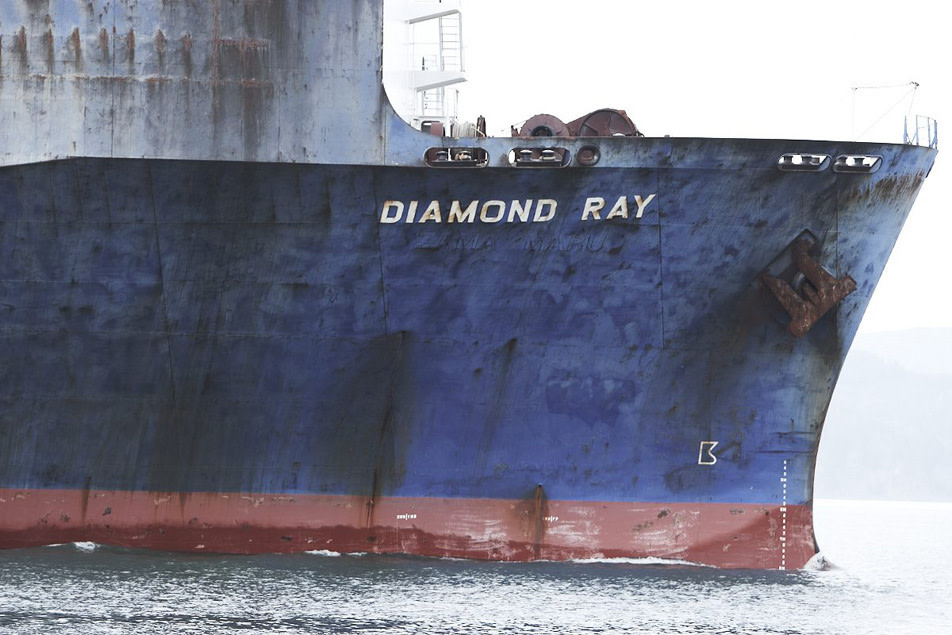
The hull of the Diamond Ray plows towards Astoria.
UP ON COXCOMB HILL, the highest point in Astoria, the rain is turning to sleet. The temperature is dropping; clouds are balling up like fists. The threat of worse to come and the potential for an icy slog back down to town is enough to drive away the few tourists milling about at the foot of the Astoria Column. The 125-foot historical landmark stands 600 feet above sea level; its 164-step staircase winds all the way to the top, affording, by far, the best views of the Columbia River and its tumultuous exit to the sea.
The 1,290-mile Columbia begins in Alberta, Canada, and runs down past towns like Revelstoke, Shelter Bay, Nakusp, and Castlegar, and then through Washington State to form the 309-mile border with Oregon. North of Portland, the Columbia meets the Willamette River, then veers northwest and on to Astoria, where it empties into the Pacific at 265,000 cubic feet per second, a force that’s been compared to that of a fire hose. Throw in Astoria’s reputation for fog and occasional hurricane-force winds, and it’s easy to understand why, when charting the mouth of the Columbia in 1841, the explorer Charles Wilkes said, “Mere description can give little idea of the terrors of the bar of the Columbia; all who have seen it have spoken of the wildness of the scene, and the incessant roar of the waters, representing it as one of the most fearful sights that can possibly meet the eye of the sailor.”
The Chinook Indians are thought to be the first to navigate this slice of treachery. Then came Robert Gray, who “discovered” and named the river in 1792. By the mid-1800s, expertise in navigating the mouth of the Columbia had become a life-and-death necessity, so the Oregon Territorial Legislature formed the state’s Board of Pilot Commissioners. More than a dozen pilots have died on the job since pilots, now regulated and licensed by the Oregon Board of Maritime Pilots, began navigating these waters in the 1790s. With fourteen dams and two main jetties now stabilizing the channel a bit, the bar’s tenure as a ship-eating monster is mostly over. The job is no less dangerous; the pilots—who are required to have an unlimited master’s license, which takes ten to fifteen years to achieve, along with two years as a captain—are now trained to react to the bar’s temperament. The channel is six hundred feet wide and forty-three feet deep in most places. Ships are upward of nine hundred feet long and can sit forty feet deep in the water, leaving three feet of wiggle room. The pilots have to know just how and when to wiggle.
These days, the biggest challenge isn’t physical survival as much as economic: the pilots need to keep bar traffic flowing as efficiently as possible. On average, forty million tons of incoming cargo worth $18 billion crosses the Columbia bar every year, making its way to log ports like Longview, and to burgeoning auto hubs like Vancouver, and to Portland, where cars, break-bulk steel, grains, and potash alone contribute $693 million a year to the local economy. Oregon is also the country’s seventh-largest exporter per capita, sending out more than ten million tons of grain and other cargo, and more than four hundred thousand automobiles. When Columbia River ports and pilots compete with much of the West Coast for business, and to some extent with the Mississippi River, the pressure is on. “Competitive shipping is critical,” says Captain Robert Johnson, a twenty-one-year bar veteran. “There are very large sums of money involved, so there is pressure to keep the bar open, but not at the expense of safety.”
In 2007, a sea storm blowing at sixty-five miles per hour shut the bar down for three days. And on January 9, 2006, fifty-year-old Kevin Murray, a bar pilot for less than two years, lost his footing while trying to transfer from a 609-foot outbound log carrier to the Chinook, the bar pilots’ other boat. He fell into the water and couldn’t be rescued. His body was recovered two days later, seventy miles up the coast. Murray’s widow, Lori, sued both the owner of the boat from which he was trying to disembark and the owner of the Chinook. They ultimately settled the matter out of court. So when Captain Johnson says, “Around here, the edge is something we can expect to face,” he’s not beating his chest. He’s stating a fact. “I can lose a ship if I make a bad decision out here, and there are very few other places in the world where that can happen. But that’s why they call us. If you had brain cancer, you wouldn’t go to a heart surgeon.”
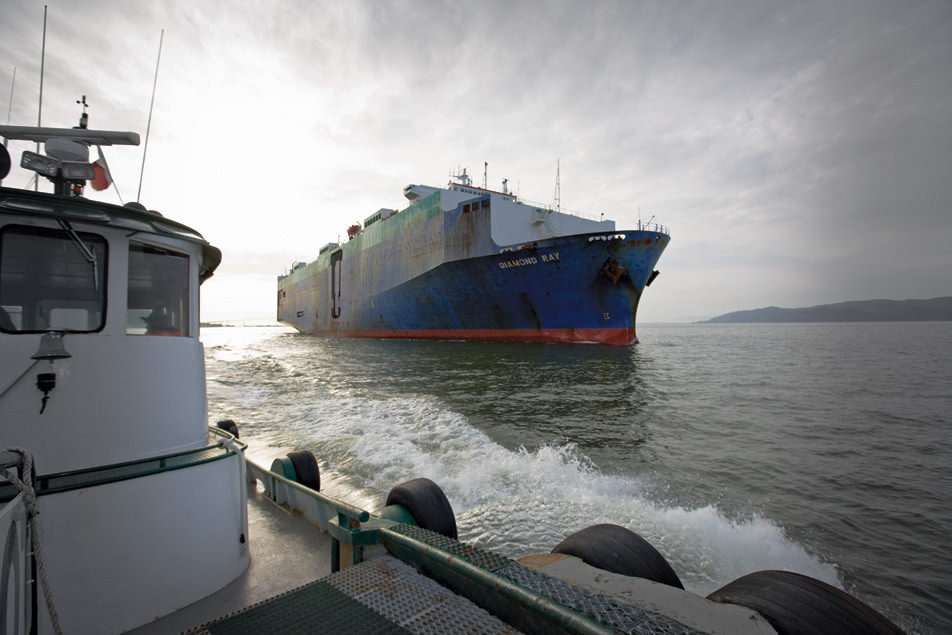
The Diamond Ray heads on upriver toward Portland.
THE BAR PILOTS’ headquarters is a shake-shingled shoebox located next door to the Columbia River Maritime Museum. The salt air has eroded any color, the roof needs repair, and the sea has ground the neighboring docks down to stumps.
Inside, photos from the association’s 163-year history line the walls. A late-1800s portrait features pilots sporting bushy mustaches and bowlers and wielding telescopes and rolled-up charts like billy clubs—they look exactly like the type of guys who would voluntarily risk their lives to navigate a brutal body of water. Another photo shows the bar itself in all its vicious glory: enormous waves momentarily obliterate the deck of a steamship—ropes extending out of the water and up to the mast are the only clue that a boat lies just beneath the waves.
Down the main hall, past the bunk rooms and lockers, Ralph Siegrist sits in the dispatch room, compiling the day’s list of inbound and outbound ships. It’s 8 a.m. on a Wednesday, and he is alone. The air smells like coffee and stale farts. A tug-towed car barge—which looks like Portland’s US Bancorp Tower in floaties—passes by slowly, temporarily filling the entire bayside window. Beyond that, three other ships sit anchored in the harbor, waiting for berth so they can load their cargo.
This building is the epicenter of bar pilot operations. Whether a ship is headed up the Columbia to Longview, Kalama, or Portland’s Terminal 6—the river’s primary ocean-container terminal—or back out to sea, every international vessel that passes through Astoria first must check in with dispatch to arrange a bar-pilot boarding. Oregon law requires foreign-trade ships to carry a Columbia River bar pilot when crossing the bar. “About the time some captains see land, they start to get nervous,” Siegrist says. “That’s when we usually get the call.”
Captain Johnson shuffles into the dispatch office, sheds his rain gear, and throws himself into a chair. In his oatmeal sweater and slacks, he looks like Paul Newman. He’s been on since 1 a.m., but he wants to listen to the radio before heading home to bed. Every weekday morning, the local public radio station, KMUN, delivers a ship report, updating listeners on incoming and outgoing vessels. Via the muted, smoky tones of KMUN reporter Joanne Rideout, the words “laying telecom cable” never sounded quite so alluring. “She knows her stuff,” Siegrist says.
It’s an anachronistic scene: two men sitting around a hand-crank radio, listening to somebody talk about boats. But labeling these pilots “men out of time” isn’t exactly over the line. Even as a $194 million project to deepen the Columbia’s shipping channel by three feet nears completion—a move that would authorize ships to carry six thousand to ten thousand more tons of cargo than is currently allowed—the bad news has kept pace. In 2004, the Hyundai Merchant Marine line stopped shipping via the Columbia, and the “K” Line, one of two Asian shipping links, pulled out in April. A 20 to 30 percent drop in business across the board has forced the Port of Portland to trim $7.5 million from its budget by, in part, instituting pay cuts and furloughs.
In Clatsop County, home to Astoria, unemployment has nearly doubled, to 8.4 percent in the past year—that’s more than two thousand jobs, and is quite a blow to a place whose very identity rests on shipping. “People still pay attention to the scanners in their house,” Captain Johnson says. “I know that somewhere in town there’s a little old lady waiting by her radio, and I know that it probably makes her feel better to know where the ship she sees out her window is going.” Johnson used to sound the horn whenever he was in the wheelhouse: one long blast, two short—the bar pilot signal that a ship was en route somewhere. But there were complaints about the horn, so he stopped.
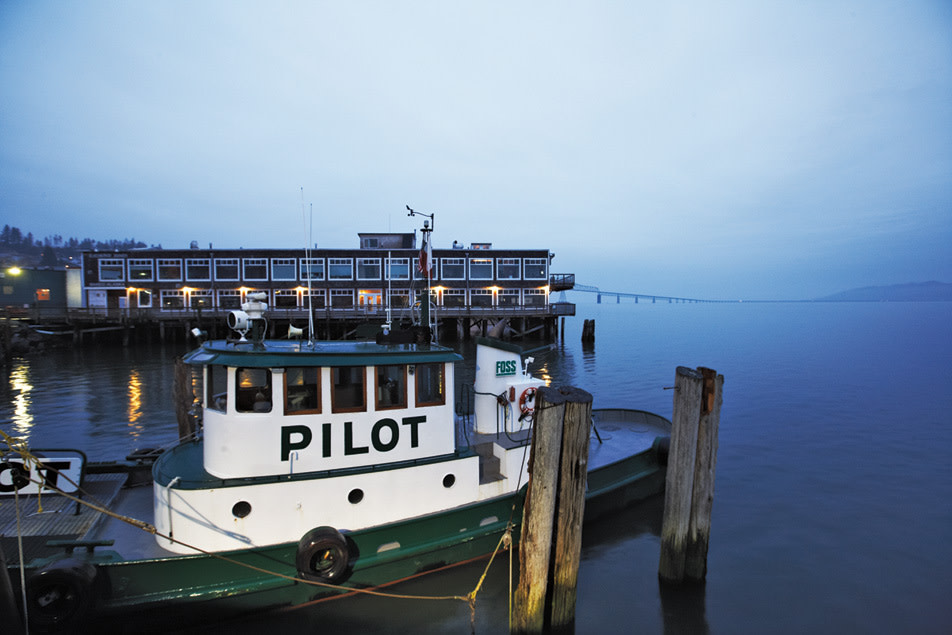
A tugboat that fetches pilots once they’ve guided ships in from sea.
“I’M NOT GOING TO LIE TO YOU: this thing is built to take a beating.” Michael Bruhn, the hoist operator on the bar pilot’s Seahawk helicopter, is yelling over the banshee howl of helicopter blades. “It’ll run on one engine if it has to. So if we have to ditch, it’s because something unexpected happened. And if that’s the case, we’re done. But at least you won’t be alone. It’s not some prank—we’re all dead.” We’re at the bar pilots’ ramshackle helo-base at the Astoria airport, and Kevin Rebrook, the pilot, has just asked me for an emergency contact number: “In case you don’t come back.”
This isn’t black humor; it’s protocol. Seventy percent of ship boarding is done via helicopter, because choppers get out to the ships faster than pilot boats, and the boats are often in use. Ships barely have to slow down for a chopper to land—the bar pilots call it “walking to work.” Otherwise, pilots are lowered aboard with a cable and harness. From fifty feet above the deck of a ship, Bruhn feeds and kills line with the push of a button. If things get sketchy for the chopper and the pilot is dangling within ten feet of the deck, Bruhn will cut him loose—it’s not a far enough drop to be fatal, and it’s better than everyone crashing into the Pacific.
Captain Barry Barrett saunters up the runway. Pale beard, face raw from spending forty of his sixty years on the ocean (twenty of them as a bar pilot), he is a potent mix of Santa Claus and beef jerky. He locks himself into his seat on the Seahawk, gives the thumbs-up. Within minutes after liftoff, the Oriente Sky, a 506-foot Panamanian bulk carrier, grows from a blip on the radar to a mass of steel just a few feet beneath us. The deck features a four-story wheelhouse and four towering cranes, which allow the crew to load and unload cargo without calling in that kind of equipment at port. Despite the obstacles, Rebrook decides to forgo the hoist and land.
The landing pad is a closed cargo hatch sandwiched between one of those cranes and the wheelhouse. The Seahawk is forty-two feet long, the touchdown point fifty-four feet in diameter. Rebrook has to negotiate that tricky math and keep the chopper moving at a steady thirty miles an hour—a moving target hitting a moving target.
It’s hard to tell if the Oriente’s crew members are taking pictures because they’ve never seen a chopper land here before or because they have shows like Horrible Videotaped Death Crash back in Panama that they’d like to submit the images to. But, as with Kevin Dooney’s workmanlike boarding on the Columbia, this touchdown is horrifyingly smooth.
As a welcoming party guides us over and around exhaust pipes and portholes, a man with a walkie-talkie steps forward and shakes Captain Barrett’s hand. Barrett follows the fellow up four flights of metal stairs. The air smells strongly of fish.
“Hello, gentlemen!” Barrett’s voice rattles the Jesus posters hung along the wheelhouse walls. He and the Panamanian captain begin a well-rehearsed dance, trading information about the ship in broken English, checking the radar, double-checking maps. Barrett is now in charge of a vessel weighing twenty-four thousand dead-weight tons and a crew he’s never met in his life until now.
“Port ten,” he calls out.
Port ten, the baby-faced boy at the wheel calls back.
“Midship,” Barrett commands.
Midship.
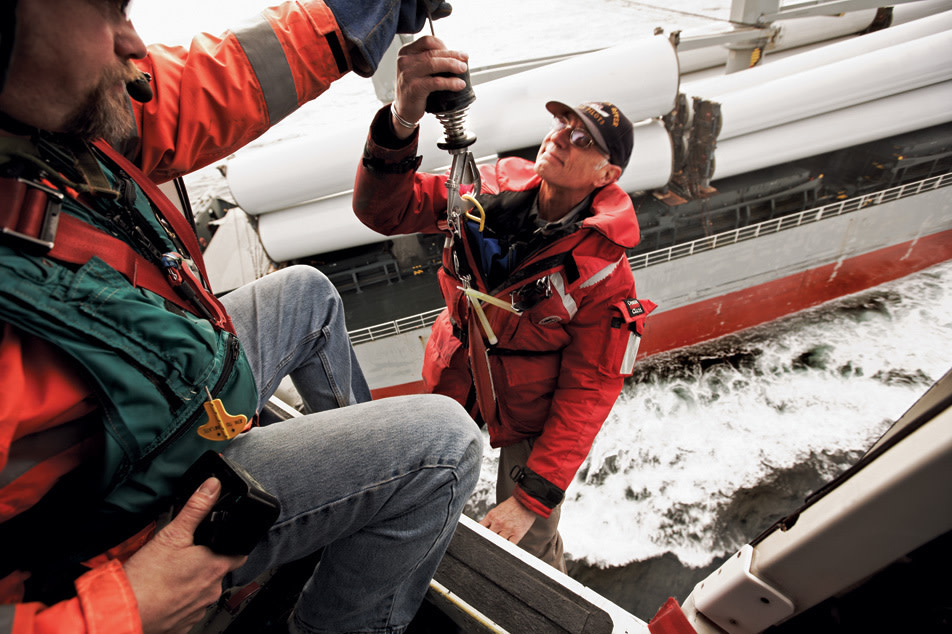
Seahawk winch operator Michael Bruhn hoists bar pilot George Waer from the Tritonia.
The ship enters the bar, skirting the buoys that lead the way to Astoria. Barrett, who used to pilot ships for Chevron, pulls out an ancient metal stopwatch and clocks the time between markers, then inscribes numbers in a small, leather-bound notebook; there are sixteen more journals just like it in his desk at home, filled with the logs of more than four thousand trips over the bar. In most occupations that require any combination of physical and mental prowess, a person’s prime consists of a pocket of years in the twenties and thirties, when bone and muscle are firm. But most pilots, like Barrett, are well into their fifties and sixties when they peak as captains.
The sun is out now, the jagged edge of Cape Disappointment within sight. The Oriente moves so smoothly, it’s almost as if we’re aboard a pleasure craft. Barrett starts telling sea tales—about the odd feeling of boarding and acclimating to another captain’s vessel, about cat-size wharf rats kept as pets, about bleary-eyed Indian sailors asking how to get to Japan, about one captain’s wife who made a boatswain paint the elevator pink.
As we ease into the shadow of the Astoria-Megler Bridge, I can’t help but notice that Barrett hasn’t so much as looked at a radar or computer screen. Is it possible, I ask, to navigate this huge hunk of steel and men just by using the jigsaw coast as a guide? Barrett stops writing in his pad. The wrinkles in his face coalesce into a smile. “What do you think I just did?”




